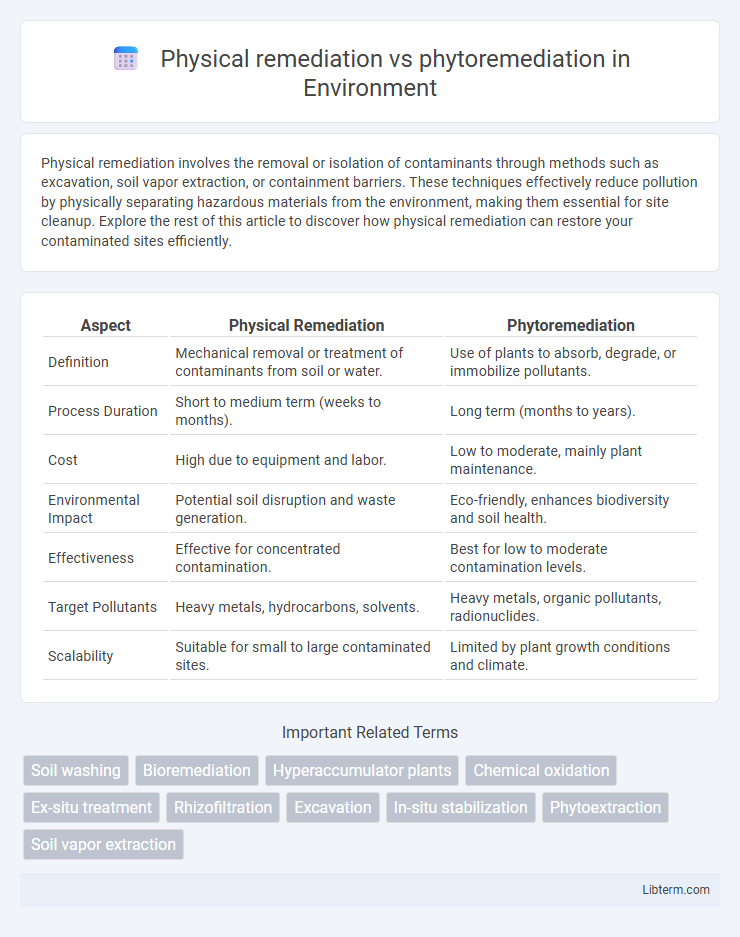Physical remediation involves the removal or isolation of contaminants through methods such as excavation, soil vapor extraction, or containment barriers. These techniques effectively reduce pollution by physically separating hazardous materials from the environment, making them essential for site cleanup. Explore the rest of this article to discover how physical remediation can restore your contaminated sites efficiently.
Table of Comparison
| Aspect | Physical Remediation | Phytoremediation |
|---|---|---|
| Definition | Mechanical removal or treatment of contaminants from soil or water. | Use of plants to absorb, degrade, or immobilize pollutants. |
| Process Duration | Short to medium term (weeks to months). | Long term (months to years). |
| Cost | High due to equipment and labor. | Low to moderate, mainly plant maintenance. |
| Environmental Impact | Potential soil disruption and waste generation. | Eco-friendly, enhances biodiversity and soil health. |
| Effectiveness | Effective for concentrated contamination. | Best for low to moderate contamination levels. |
| Target Pollutants | Heavy metals, hydrocarbons, solvents. | Heavy metals, organic pollutants, radionuclides. |
| Scalability | Suitable for small to large contaminated sites. | Limited by plant growth conditions and climate. |
Introduction to Environmental Remediation
Physical remediation involves the direct removal or containment of contaminants from soil, water, or air through techniques such as excavation, soil washing, or air sparging. Phytoremediation uses plants to absorb, concentrate, and degrade pollutants, offering a cost-effective and sustainable alternative for certain contaminants like heavy metals, pesticides, and hydrocarbons. Both methods play crucial roles in environmental remediation by addressing pollution through distinct mechanisms tailored to specific site conditions and contaminant types.
Understanding Physical Remediation
Physical remediation involves the direct removal or isolation of contaminants from soil, water, or air using mechanical methods such as excavation, soil washing, or containment. This approach provides immediate reduction of pollutant concentration and is effective for sites with concentrated or heavy contamination. Understanding physical remediation is crucial for selecting appropriate techniques based on site conditions, contaminant type, and remediation goals.
Key Processes in Physical Remediation
Physical remediation involves processes such as soil excavation, sediment dredging, and air sparging to remove or isolate contaminants from environmental media. Techniques like soil washing and membrane filtration are employed to physically separate pollutants based on particle size or chemical properties. These methods are effective for immediate contaminant removal but often require extensive equipment and energy inputs compared to phytoremediation's plant-based absorption and degradation mechanisms.
What is Phytoremediation?
Phytoremediation is an eco-friendly, cost-effective technique that uses plants to remove, stabilize, or degrade contaminants in soil, water, and air. Unlike physical remediation methods that involve excavation or chemical treatments, phytoremediation utilizes natural biological processes such as phytoextraction, phytostabilization, and rhizodegradation to restore polluted environments. This method is effective for heavy metals, organic pollutants, and radionuclides, making it a sustainable alternative for environmental cleanup.
Core Mechanisms of Phytoremediation
Phytoremediation harnesses the natural ability of plants to extract, degrade, or stabilize contaminants through processes like phytoextraction, phytodegradation, and phytostabilization, contrasting with physical remediation that primarily relies on mechanical removal or chemical treatments. Key mechanisms include uptake of pollutants by roots followed by translocation and accumulation in harvestable tissues, enzymatic breakdown of organic contaminants within plant cells, and immobilization of heavy metals in the rhizosphere to reduce bioavailability. This biologically driven approach offers a sustainable, cost-effective solution for remediating soils and water contaminated with heavy metals, hydrocarbons, and pesticides.
Comparative Effectiveness: Physical vs Phytoremediation
Physical remediation techniques such as soil excavation, sediment dredging, and pump-and-treat methods offer rapid contaminant removal but tend to be costly and disruptive to the environment. Phytoremediation, utilizing plants like poplars and willows to absorb, degrade, or immobilize pollutants, provides a sustainable and cost-effective solution, although it typically requires longer timeframes and is more suitable for low to moderate contamination levels. Comparative effectiveness depends on site-specific factors including contaminant type, concentration, and soil conditions, with integrated approaches sometimes employed to optimize remediation outcomes.
Environmental Impact Analysis
Physical remediation techniques such as soil excavation and sediment dredging often cause significant habitat disruption and generate large volumes of waste requiring disposal, leading to secondary pollution risks. Phytoremediation employs plants to absorb, accumulate, and detoxify contaminants, resulting in minimal disturbance to ecosystems and enhanced soil structure over time. Environmental Impact Analysis consistently shows that phytoremediation offers a sustainable, low-cost alternative with reduced carbon footprint and improved biodiversity retention compared to aggressive physical methods.
Cost and Resource Considerations
Physical remediation often requires substantial capital investment for heavy machinery and extensive labor, leading to higher upfront costs and increased energy consumption. Phytoremediation leverages plants to detoxify contaminants, offering a cost-effective alternative with lower operational expenses and minimal resource input, especially in large or inaccessible areas. However, phytoremediation may demand longer time frames and ongoing maintenance, balancing its low cost with potential delays in environmental recovery.
Case Studies: Success Stories and Challenges
Case studies reveal that physical remediation methods, such as soil excavation and sediment dredging, effectively remove contaminants quickly but often incur high costs and cause environmental disruption. Phytoremediation success stories highlight the use of plants like poplar trees and Indian mustard to extract heavy metals and organic pollutants, offering cost-effective and eco-friendly solutions, though challenges remain with slow remediation rates and depth limitations. Both approaches demonstrate site-specific efficacy, with integrated strategies increasingly adopted to enhance overall remediation outcomes.
Future Trends in Soil and Water Remediation
Future trends in soil and water remediation highlight the integration of physical remediation techniques such as soil vapor extraction and pump-and-treat systems with phytoremediation methods, leveraging fast-growing hyperaccumulator plants like poplar and willow to enhance contaminant uptake. Advances in nanotechnology and genetic engineering are expected to improve phytoremediation efficiency by developing plants with tailored metabolic pathways for specific pollutants such as heavy metals and organic contaminants. The convergence of real-time monitoring sensors and AI-driven data analysis is poised to optimize remediation processes, enabling adaptive management strategies that reduce costs and environmental impacts.
Physical remediation Infographic

 libterm.com
libterm.com